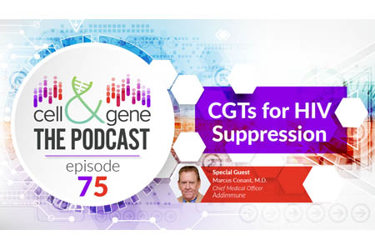Is A One-Time Cure for HIV on the Horizon?

By Erin Harris, Editor-In-Chief, Cell & Gene
Follow Me On Twitter @ErinHarris_1

Cell & Gene: The Podcast features some of the CGT sector’s brightest leaders who share their expertise on the timeliest topics and trends. If you can’t tune in to every episode, I’ve got you covered. Here are highlights, quotes, and more from a recently aired episode.
The Episode:
CGTs For HIV Suppression with Addimmune's Dr. Marcus Conant
Guest At-A-Glance
Marcus Conant, MD, was one of the first physicians at ground zero of the HIV/AIDS epidemic in the early 1980s. He treated thousands of HIV patients in the early 80s and ran the inpatient dermatology service at the University of California San Francisco. Dr. Conant took the lead in forming the Kaposi’s Sarcoma Research & Education Foundation in 1982, which later became the San Francisco AIDS Foundation. He has published more than 70 articles on the treatment of AIDS, testified in front of Congress multiple times, and is a powerful advocate for the LGBTQ+ community.
Company At-A-Glance
Addimmune is a cell and gene therapy company that is developing a functional cure for HIV. The company’s lead asset, AGT103-T, is designed to provide broad protection using silencing RNA to inhibit binding/entry of the virus, halt replication, and prevent escape. This one-and-done treatment candidate is being developed to mitigate the concern of poor adherence and treatment failure with the current standard of care.
In Summer 2023, CEO Jeff Galvin led Addimmune’s spinout from its parent company American Gene Technologies, which he founded in 2008. Addimmune is the product of 15 years of research and development by American Gene Technologies. The company believes in the potential of its technology and was compelled to create a company exclusively dedicated to the pursuit of a functional cure for HIV.
Episode Highlights
In the Clinic
Dr. Conant explains Addimmune’s Phase 1a clinical study that evaluated the safety and durability of AGT103-T in seven people living with HIV. The team also sought to evaluate the effectiveness of the modified T cells.
The participants received AGT103-T modified cells via infusion, followed by up to 180 days of monitoring post infusion for potential adverse events. They observed no serious adverse events; the modified CD4 T cells were engrafted and persisted in all participants; and the CD4 T cells maintained their functionality. Addimmune also observed a consistent expansion of the CD4 T cells in patients that peaked approximately 14-days post infusion, an unexpected response that provided key insight into how best to design the next trial protocol.
The Immune System Is Like an Orchestra
Dr. Conant compared the immune system to an orchestra with the T cell as its conductor. HIV kills the conductor (i.e. the T cell) of the immune orchestra. But to enter the cell, the virus must first attach to the CD4 receptor on the surface of the cell. The CCR5 protein is necessary for the virus to enter the cell. Throughout our discussion, Dr. Contant explained the role of the CCR5 protein as well as Addimmune’s safety trial, which required removing patient’s T cells. Addimmune manufactured the cells and included a lentiviral vector to block CCR5 before re-infusing those cells into the patients.
Top Quotes
1:21: “We're trying to find a functional cure for HIV. Now, let's remind the listeners we know that we can cure HIV. There have been six patients worldwide who’ve been cured of the disease by putting in cells that block the entrance of the virus into T cells via bone marrow transplants in six patients. What we’re trying to do is to use cell and gene therapy to do the same thing without having to do a bone marrow transplant.
Now, the reason bone marrow transplants won't work for large numbers of patients is less than 5% of people have the right kind of cells. Five percent of the people who receive bone marrow transplants die of the procedure. Well, obviously it’s unethical to do something to patients where we can treat them with a pill that doesn’t kill the patient. Finally, the cost is prohibitive. And so, using that same concept, the way of blocking the entrance of the virus through cell and gene therapy into T cells is what we're trying to do. To develop a one-and-done cure for HIV.”
9:33: “The research shows up to 20% of people know they’re positive. In other words, they’ve been tested. The antibody test comes back, they know they’re positive, but they are not taking medication. And in my view, that should be studied intensely to find out what is the barrier. It looks as if they’re afraid of the cost.
There’s More Where That Came From
No doubt about it – the real value is in the full-length episode. Listen in to hear Dr. Conant discuss the history of HIV treatment, how a one-time therapy could have a global impact on HIV, and more.
